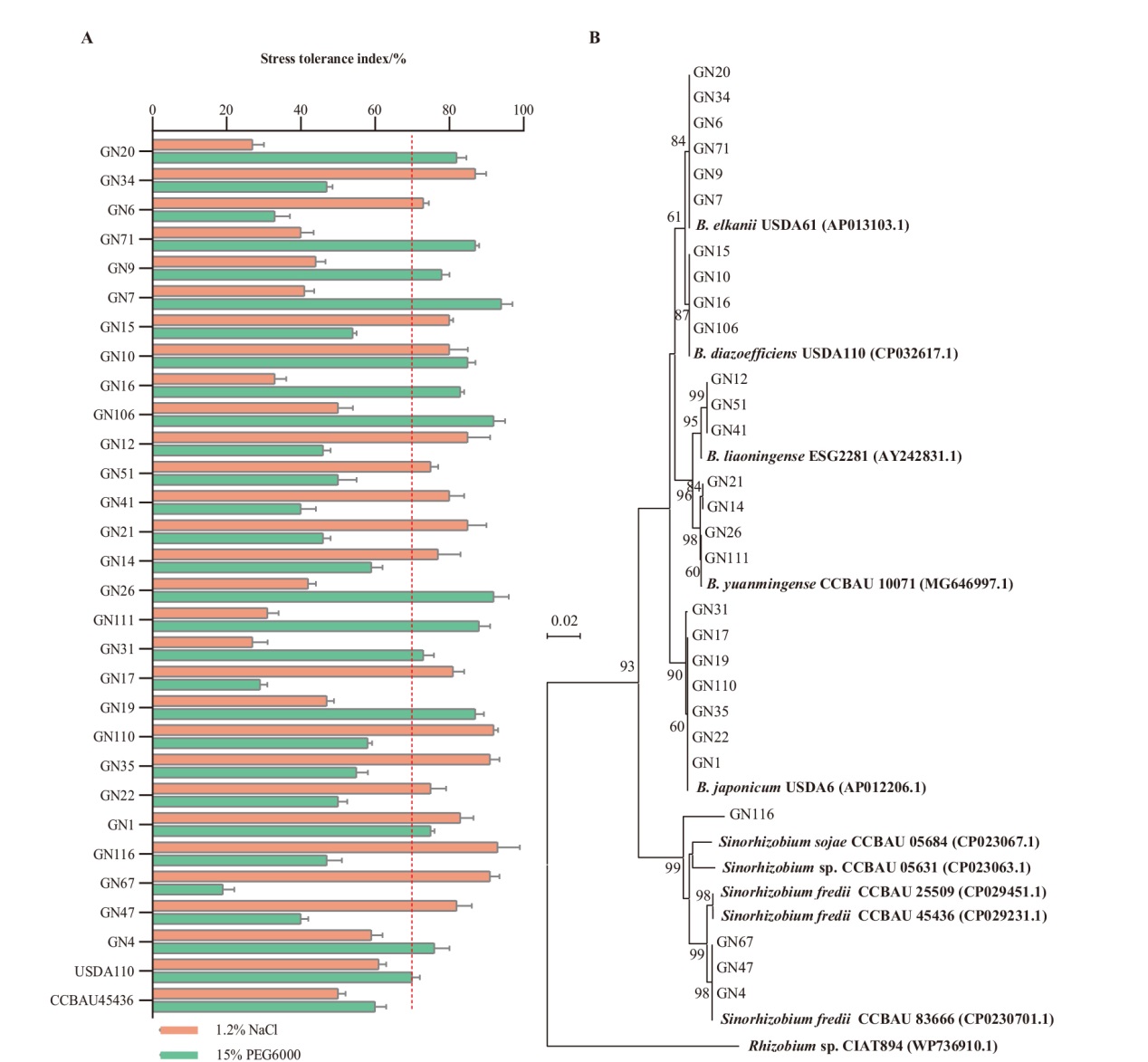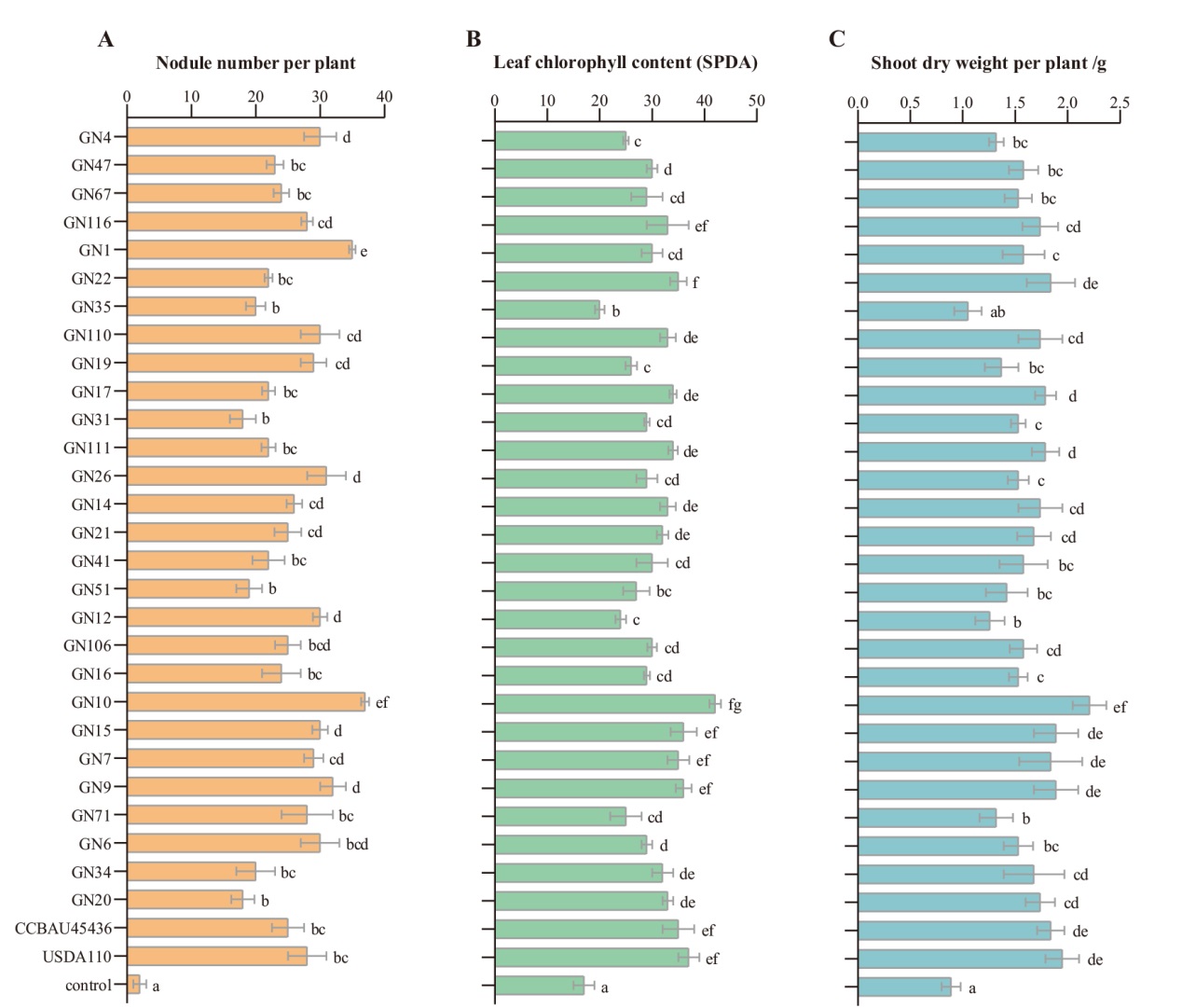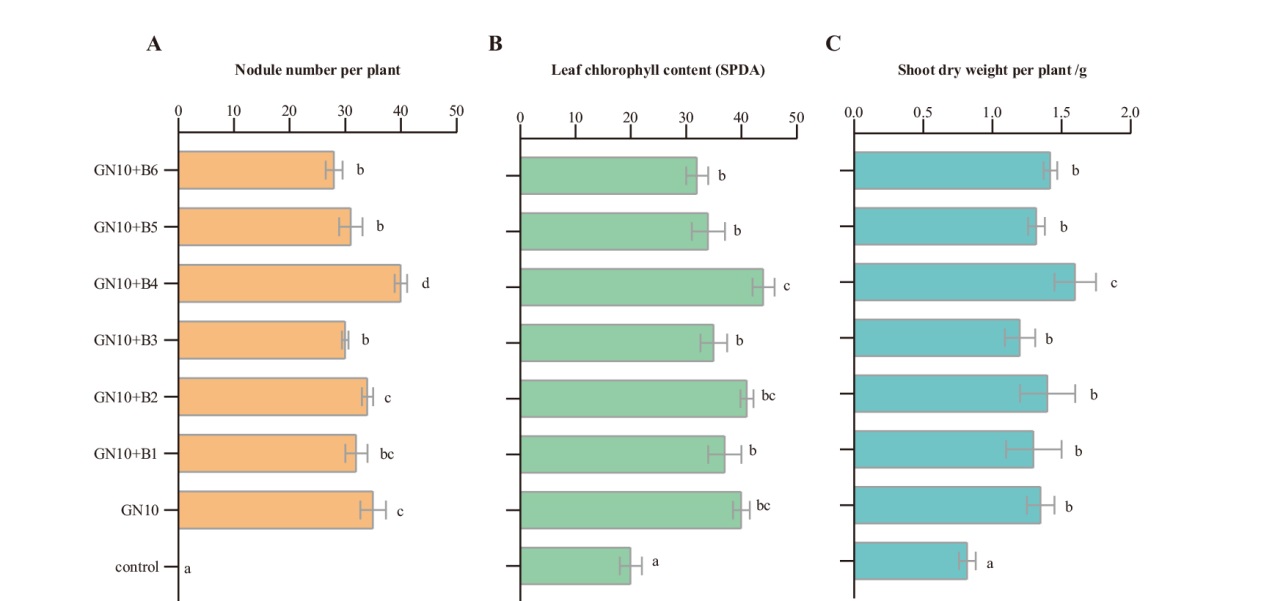








生物技术通报 ›› 2025, Vol. 41 ›› Issue (1): 252-262.doi: 10.13560/j.cnki.biotech.bull.1985.2024-0564
收稿日期:2024-06-13
出版日期:2025-01-26
发布日期:2025-01-22
通讯作者:
崔文靖,男,博士,高级工程师,研究方向:功能微生物资源及其产业化; E-mail: wjcui@agreenbio.com;作者简介:刘克寒,女,博士,研究方向:微生物的多样性及应用; E-mail: liukehan@sinochem.com
基金资助:
LIU Ke-han1( ), YANG Sheng-hui2, HUANG Qiao-yun3(
), YANG Sheng-hui2, HUANG Qiao-yun3( ), CUI Wen-jing4(
), CUI Wen-jing4( )
)
Received:2024-06-13
Published:2025-01-26
Online:2025-01-22
摘要:
【目的】黑龙江是我国大豆的主产区,有着丰富的大豆根瘤菌资源,针对该区域筛选优质抗逆大豆根瘤菌及根际促共生菌株对于大豆的提质增产至关重要。【方法】从黑龙江采集根瘤、根际土分离纯化大豆根瘤菌、根际菌,通过rpoB、16S rRNA基因测序进行种属鉴定。在试管培养条件下进行根瘤菌菌株对盐胁迫(1.2% NaCl)、干旱胁迫(15% PEG6000)的耐受性评价。胁迫耐受根瘤菌菌株接种到黑河43,筛选高效共生菌株。代表性根瘤菌菌株及其根际促共生菌株混合菌接种到黑河43,获得高效共生根瘤菌及促共生显著的菌株。【结果】(1)分离获得大豆根瘤菌136株,其中129株慢生型根瘤菌(分属于Bradyrhizobium elkanii、B. japonicum、B. diazoefficiens、B. yuanmingense、B. liaoningense);7株快生型根瘤菌(分属于Sinorhizobium fredii、Sinorhizobium sp.)。(2)分离获得拮抗大豆根腐病病原菌(镰刀菌)的菌株6株(B1-B6,分属于Bacillus velezensis、B. subtilis、B. licheniformis、B.cereus、B. megaterium),其中有4株(B1、B2、B4、B5)具有产IAA的能力。(3)获得耐盐或耐旱代表性大豆根瘤菌28株,其中有两株大豆根瘤菌B. japonicum GN1、B. diazoefficiens GN10对盐胁迫、干旱胁迫均具有较好抗性,并且通过共生表型的筛选确定GN10是代表菌株中最为高效的大豆根瘤菌。(4)混合接种大豆表型结果表明,B. velezensis B4相比于其余5株芽胞杆菌可以显著提升B. diazoefficiens GN10的共生表现。【结论】成功获得耐盐、耐旱且共生效率高的慢生大豆根瘤菌1株,同时获得对共生表现促进效果显著的贝莱斯芽胞杆菌1株,为高效复合根瘤菌菌剂的开发及应用提供有力支撑。
刘克寒, 杨升辉, 黄巧云, 崔文靖. 黑龙江大豆根瘤菌及根际促共生菌株的筛选及应用[J]. 生物技术通报, 2025, 41(1): 252-262.
LIU Ke-han, YANG Sheng-hui, HUANG Qiao-yun, CUI Wen-jing. Isolation and Application of Soybean Rhizobia and Symbiosis-promoting Rhizobacteria from Heilongjiang Province[J]. Biotechnology Bulletin, 2025, 41(1): 252-262.

图1 大豆根瘤菌的物种数和物种丰度 A:分离根瘤菌菌种的数量统计,图内数字表示菌株数;B:不同采样点菌株相对丰度
Fig. 1 Species number and relative abundance of isolated soybean-nodulating rhizobia A: Statistics of the species number of isolated soybean-nodulating rhizobia, the number in the Figure indicate the number of a strain. B: The relative abundance of isolates in different sampling sites

图2 根瘤菌对盐胁迫、干旱胁迫的耐受性及其rpoB进化树 A:根瘤菌对模拟盐胁迫、干旱胁迫的耐受性,耐受性指数阈值70%所在位置用红色虚线标识; B:基于不同根瘤菌rpoB基因构建的系统发育树,共计39条rpoB基因序列(28株候选菌株,11株参比菌株),采用Mega X最大似然法构建进化树,Bootstrap值高于60%的在分支节点用数字标明,参比菌株的rpoB 在 GenBank 的序列号在括号内备注。GN为Green Nitrogen缩写
Fig. 2 Tolerances of isolated rhizobia strains to salt and drought and its rpoB phylogenetic tree A: Tolerances of isolated strains to simulated salt and drought. The index threshold(70%)of tolerance to stress is indicated by red dotted line. B: Phylogenetic tree was constructed based on rpoB genes of different rhizobia, totally 39 rpoB sequences((28 candidates, 11 reference strains).)by Mega X maximum likelihood software. Bootstrap values above 60% are shown at the branch points. Accession numbers of the reference sequences from GenBank are given in brackets. GN is the abbreviation of Green Nitrogen

图3 高效共生根瘤菌的筛选 根瘤数(A)、叶绿素含量(B)、地上部干重(C)3个指标用来衡量单个根瘤菌菌株与大豆的共生表现。误差线采用SD,均值间显著差异基于ANOVA单因素分析Tukey检验用不同字母表示(α=0.05)
Fig. 3 Screening of highly efficient symbiotic rhizobial strains Nodule number(A), leaf chlorophyll content(B), shoot dry weight(C)are measured to evaluate the effects of the symbiotic performance of individual rhizobia on soybean. Error bars are for SD. Significant differences among means are indicated by different letters based on ANOVA followed by Tukey's test(α = 0.05)

图4 根际抗病、促生菌株及其16S rDNA序列系统发育树 A:六株拮抗大豆根腐病原菌的芽胞杆菌及其产IAA能力检测。大豆根腐病病原菌选取Fusarium oxysporum,IAA产量通过显色深浅来衡量;B:基于不同芽胞杆菌16S rRNA基因构建的系统发育树,共计25条16S rDNA序列(6株候选菌株,19株参比菌株),采用Mega X最大似然法构建进化树
Fig. 4 Disease-resistant and growth-promoting rhizobacteria and its phylogenetic tree of 16S rDNA A: Six bacillus strains antagonizing soybean root rot pathogen and producing IAA test. Fusarium oxysporum was a selected soybean root rot pathogen, IAA production was measured by color intensity. B: Construction of phylogenetic tree based on 16S rRNA genes of different Bacillus strains. Maximum likelihood phylogenetic trees of 25(6 candidates, 19 reference strains)16S rDNA sequences was constructed by Mega X maximum likelihood software

图5 根际促共生菌与大豆根瘤菌的混合接种表现 根瘤数(A)、叶绿素含量(B)及地上部干重(C)3个指标用来衡量单个根瘤菌菌株与大豆的共生表现。误差线采用SD,均值间显著差异基于ANOVA单因素分析Tukey检验用不同字母表示(α=0.05)
Fig. 5 Performance of co-inoculation of symbiosis-promoting rhizobacteria and soybean-nodulating rhizobia Nodule number(A), leaf chlorophyll content(B)and shoot dry weight(C)were measured to evaluate the effect of the symbiotic performance of individual rhizobia on soybean. Error bars are for SD. Significant differences among means are indicated by different letters based on ANOVA followed by Tukey's test(α = 0.05)
| [1] | Martin FM, Uroz S, Barker DG. Ancestral alliances: Plant mutualistic symbioses with fungi and bacteria[J]. Science, 2017, 356(6340): eaad4501. |
| [2] |
Poole P, Ramachandran V, Terpolilli J. Rhizobia: from saprophytes to endosymbionts[J]. Nat Rev Microbiol, 2018, 16(5): 291-303.
doi: 10.1038/nrmicro.2017.171 pmid: 29379215 |
| [3] | 王亚君, 于寒松, 舒坤良. 中国大豆产业发展特点、趋势及对策[J]. 社会科学战线, 2024(4): 253-258. |
| Wang YJ, Yu HS, Shu KL. Characteristics, trends, and countermeasures of the development of China's soybean industry[J]. Soc Sci FRONT, 2024(4): 253-258. | |
| [4] | Wu YS, Wang EL, Gong WZ, et al. Soybean yield variations and the potential of intercropping to increase production in China[J]. Field Crops Res, 2023, 291: 108771. |
| [5] | 朱梓菲, 刘鑫磊, 薛永国, 等. 黑龙江省大豆生产现状与发展建议[J]. 中国种业, 2020(8): 18-23. |
| Zhu ZF, Liu XL, Xue YG, et al. Current status and development suggestions of soybean production in Heilongjiang province[J]. China Seed Ind, 2020(8): 18-23. | |
| [6] | 伍惠, 钟喆栋, 王学路, 等. 与黑龙江大豆主栽品种匹配的优良根瘤菌筛选与鉴定[J]. 应用与环境生物学报, 2018, 24(1): 39-46. |
| Wu H, Zhong ZD, Wang XL, et al. Screening and identification of elite rhizobia matched with main cultivars of soybean in Heilongjiang Province[J]. Chin J Appl Environ Biol, 2018, 24(1): 39-46. | |
| [7] |
Tian CF, Zhou YJ, Zhang YM, et al. Comparative genomics of rhizobia nodulating soybean suggests extensive recruitment of lineage-specific genes in adaptations[J]. Proc Natl Acad Sci USA, 2012, 109(22): 8629-8634.
doi: 10.1073/pnas.1120436109 pmid: 22586130 |
| [8] | 王卫卫, 关大伟, 马鸣超, 等. 东北地区大豆根瘤菌遗传多样性与系统发育研究[J]. 大豆科学, 2013, 32(4): 433-437. |
| Wang WW, Guan DW, Ma MC, et al. Genetic diversity and phylogeny of soybean rhizobia isolated from Northeast China[J]. Soybean Sci, 2013, 32(4): 433-437. | |
| [9] |
王晓丽, 秦杰, 王敏, 等. 山西大豆根瘤菌的分离、鉴定及共生匹配性筛选[J]. 生物技术通报, 2022, 38(3): 59-68.
doi: 10.13560/j.cnki.biotech.bull.1985.2021-1315 |
| Wang XL, Qin J, Wang M, et al. Isolation, identification and symbiotic matching of soybean rhizobia from Shanxi Province[J]. Biotechnol Bull, 2022, 38(3): 59-68. | |
| [10] | 李彦连, 王传雷, 徐保民, 等. 徐豆24大豆根瘤菌共生匹配性筛选及应用[J]. 大豆科学, 2020, 39(4): 612-620. |
| Li YL, Wang CL, Xu BM, et al. Screening and application of suitable symbiotic combination between rhizobia and soybean cultivar xudou 24[J]. Soybean Sci, 2020, 39(4): 612-620. | |
| [11] | 秦杰, 高振峰, 岳爱琴, 等. 一株晋大53号大豆中慢生根瘤菌的分离鉴定及抗逆分析[J]. 大豆科学, 2020, 39(6): 898-905. |
| Qin J, Gao ZF, Yue AQ, et al. Isolation, identification and stress resistance analysis of A Mesorhizobium isolated from soybean variety jinda 53[J]. Soybean Sci, 2020, 39(6): 898-905. | |
| [12] | 吴萍, 何庆元, 李正鹏, 等. 皖北地区大豆根瘤菌优良抗逆性菌株的筛选[J]. 安徽科技学院学报, 2012, 26(2): 15-22. |
| Wu P, He QY, Li ZP, et al. Screening of Rhizobium from soybean in North Anhui for strong resistance to stresses[J]. J Anhui Sci Technol Univ, 2012, 26(2): 15-22. | |
| [13] | 张大安. 黑龙江省土地盐碱化形成原因及治理措施[J]. 科技创业家, 2014(1): 188. |
| Zhang DA. Causes and management measures of land salinization in Heilongjiang province[J]. Technol Pioneers, 2014(1): 188. | |
| [14] | 赵杨, 赵心清. 生物对逆境环境的适应和抗逆分子育种[J]. 生物技术通报, 2023, 39(11): 1-5. |
| Zhao Y, Zhao XQ. How organisms adapt to stressful environments and molecular breeding of stress tolerance[J]. Biotechnol Bull, 2023, 39(11): 1-5. | |
| [15] | Fox SL, O’Hara GW, Bräu L. Enhanced nodulation and symbiotic effectiveness of Medicago truncatula when co-inoculated with Pseudomonas fluorescens WSM3457 and Ensifer(Sinorhizobium)medicae WSM419[J]. Plant Soil, 2011, 348(1): 245-254. |
| [16] |
Chen WF, Wang ET, Ji ZJ, et al. Recent development and new insight of diversification and symbiosis specificity of legume rhizobia: mechanism and application[J]. J Appl Microbiol, 2021, 131(2): 553-563.
doi: 10.1111/jam.14960 pmid: 33300250 |
| [17] | Younesi O, Baghbani A, Namdari A. The effects of Pseudomonas fluorescence and Rhizobium meliloti co-inoculation on nodulation and mineral nutrient contents in alfalfa Medicago sativa under salinity stress[J]. Int J Agri Crop Sci, 2013, 5(14), 1500-1507. |
| [18] | Alemneh AA, Zhou Y, Ryder MH, et al. Mechanisms in plant growth-promoting rhizobacteria that enhance legume-rhizobial symbioses[J]. J Appl Microbiol, 2020, 129(5): 1133-1156. |
| [19] | Wang ET, Tian CF, Chen WF, et al. Ecology and Evolution of Rhizobia: Principles and Applications[M]. S pringer Nature:2019. |
| [20] | Ali S, Hameed S, Shahid M, et al. Functional characterization of potential PGPR exhibiting broad-spectrum antifungal activity[J]. Microbiol Res, 2020, 232: 126389. |
| [21] | 曹轶, 崔文靖, 马瑞强. 大豆根瘤菌定向微生态研究与应用[J]. 中国农业科技导报, 2024, 26(4): 215-224. |
| Cao Y, Cui WJ, Ma RQ. Research and application of directed micro-ecology in soybean-nodulating rhizobia[J]. J Agric Sci Technol, 2024, 26(4): 215-224. | |
| [22] | 田艺心, 高凤菊, 曹鹏鹏, 等. 减氮接种根瘤菌剂对黄淮海地区高蛋白夏大豆生长发育产量和经济效益的影响[J]. 河北农业科学, 2022, 26(6): 72-77, 82. |
| Tian YX, Gao FJ, Cao PP, et al. Effects of nitrogen reducing and inoculation with Rhizobium agents on the growth, yield and economic benefit of high protein summer soybean in Huang-Huai-Hai Region[J]. J Hebei Agric Sci, 2022, 26(6): 72-77, 82. | |
| [23] | 乔李锦, 姚莉, 徐冲, 等. 皖豫高效抗逆大豆根瘤菌Y2-4的选育[J]. 大豆科学, 2024, 43(1): 45-53. |
| Qiao LJ, Yao L, Xu C, et al. Screening of highly efficient and stress-tolerant soybean Rhizobium Y2-4 used in Anhui and Henan Provinces[J]. Soybean Sci, 2024, 43(1): 45-53. | |
| [24] |
邹兰, 王茜, 李慕仪, 等. 乌头内生细菌JY-3-1R的鉴定及其生防和促生能力研究[J]. 生物技术通报, 2023, 39(10): 246-255.
doi: 10.13560/j.cnki.biotech.bull.1985.2023-0590 |
| Zou L, Wang Q, Li MY, et al. Identification, biocontrol and plant growth-promoting potential of endophytic bacterial strain JY-3-1R from Aconitum carmichaelii debx[J]. Biotechnol Bull, 2023, 39(10): 246-255. | |
| [25] | 裴晓峰, 关大伟, 李俊, 等. 耐旱大豆根瘤菌的筛选及其接种效应[J]. 大豆科学, 2012, 31(3): 420-424. |
| Pei XF, Guan DW, Li J, et al. Screening of drought-tolerance Rhizobium and its influence on soybean[J]. Soybean Sci, 2012, 31(3): 420-424. | |
| [26] | Cui WJ, Zhang BL, Zhao R, et al. Lineage-specific rewiring of core pathways predating innovation of legume nodules shapes symbiotic efficiency[J]. mSystems, 2021, 6(2): e01299-20. |
| [27] | 陈文新, 汪恩涛. 中国根瘤菌[M]. 北京: 科学出版社, 2011. |
| Chen WX, Wang ET. China rhizobia[M]. Beijing: Science Press, 2011. | |
| [28] | 张伟涛, 杨江科, 袁天英, 等. 我国南北大豆产区慢生大豆根瘤菌的遗传多样性和系统发育研究[J]. 微生物学报, 2006, 46(1): 127-131. |
| Zhang WT, Yang JK, Yuan TY, et al. Genetic diversity and phylogeny of soybean bradyrhizobia isolated from south and north region of China[J]. Acta Microbiol Sin, 2006, 46(1): 127-131. | |
| [29] | Yan J, Chen WF, Han XZ, et al. Genetic diversity of indigenous soybean-nodulating rhizobia in response to locally-based long term fertilization in a Mollisol of Northeast China[J]. World J Microbiol Biotechnol, 2016, 33(1): 6. |
| [30] | 山仑. 我国旱地农业发展中的几个问题[J]. 干旱地区农业研究, 2023, 41(3): 2-4. |
| Shan L. Issues in dryland agricultural research in China[J]. Agric Res Arid Areas, 2023, 41(3): 2-4. | |
| [31] | 陆宝金, 田生昌, 左忠, 等. 盐渍化土地可持续利用研究综述及展望[J]. 宁夏大学学报: 自然科学版, 2023, 44(1): 79-88. |
| Lu BJ, Tian SC, Zuo Z, et al. Review and prospect on sustainable utilization of salinized land[J]. J Ningxia Univ Nat Sci Ed, 2023, 44(1): 79-88. | |
| [32] |
代重阳, 孙继鑫, 王聪. 不同耐盐性菜用大豆与大豆根瘤菌的共生匹配性研究[J]. 北方农业学报, 2019, 47(6): 90-95.
doi: 10.3969/j.issn.2096-1197.2019.06.16 |
| Dai CY, Sun JX, Wang C. Symbiotic matching between soybean Rhizobium and vegetable soybean with different salt tolerance[J]. J North Agric, 2019, 47(6): 90-95. | |
| [33] | 王庆玲, 霍雪雪, 张豪, 等. 黄河口盐碱地大豆根瘤菌分离鉴定及田间应用[J]. 山东农业科学, 2023, 55(6): 143-151. |
| Wang QL, Huo XX, Zhang H, et al. Isolation, identification and field application of soybean rhizobia in saline-alkali land of the Yellow River Delta[J]. Shandong Agric Sci, 2023, 55(6): 143-151. | |
| [34] | Kibido T, Kunert K, Makgopa M, et al. Improvement of Rhizobium-soybean symbiosis and nitrogen fixation under drought[J]. Food Energy Secur, 2020, 9(1): e177. |
| [35] | Yuan K, Reckling M, Ramirez MDA, et al. Characterization of rhizobia for the improvement of soybean cultivation at cold conditions in central Europe[J]. Microbes Environ, 2020, 35(1): ME19124. |
| [36] | 朱治佳, 袁明, 韩冬伟. 浅析黑龙江省大豆根腐病研究现状[J]. 大豆科技, 2024(2): 29-34. |
| Zhu ZJ, Yuan M, Han DW. Analysis on the current research status of soybean root rot in Heilongjiang province[J]. Soybean Sci Technol, 2024(2): 29-34. | |
| [37] | 陈爽, 王继华, 张必弦, 等. 贝莱斯芽孢杆菌对大豆根腐病盆栽防效及防御酶活性检测[J]. 分子植物育种, 2022, 20(19): 6492-6500. |
| Chen S, Wang JH, Zhang BX, et al. Control effect of Bacillus ve-lezensis on soybean root rot in pot and detection of defensive enzyme activity[J]. Molecular Plant Breeding, 2022, 20(19): 6492-6500. | |
| [38] | 余水, 丁海霞, 罗玉英, 等. 贝莱斯芽孢杆菌MT310生防机制初探[J]. 山地农业生物学报, 2020, 39(5): 23-28. |
| Yu S, Ding HX, Luo YY, et al. Primary research on bio-control mechanism of Bacillus velezensis MT310[J]. J Mt Agric Biol, 2020, 39(5): 23-28. | |
| [39] | 方园, 彭勇政, 廖长贵, 等. 一株具有防病促生功能的贝莱斯芽孢杆菌SF327[J]. 微生物学报, 2022, 62(10): 4071-4088. |
| Fang Y, Peng YZ, Liao CG, et al. Bacillus velezensis SF327, a potential biocontrol agent with the functions of preventing plant diseases and promoting plant growth[J]. Acta Microbiol Sin, 2022, 62(10): 4071-4088. | |
| [40] | Sibponkrung S, Kondo T, Tanaka K, et al. Co-inoculation of Bacillus velezensis strain S141 and Bradyrhizobium strains promotes nodule growth and nitrogen fixation[J]. Microorganisms, 2020, 8(5): 678. |
| [41] | Adedayo AA, Babalola OO. Genomic mechanisms of plant growth-promoting bacteria in the production of leguminous crops[J]. Front Genet, 2023, 14: 1276003. |
| [42] | Wang TQ, Chen QQ, Liang Q, et al. Bacillus suppresses nitrogen efficiency of soybean-Rhizobium symbiosis through regulation of nitrogen-related transcriptional and microbial patterns[J]. Plant Cell Environ, 2024. DOI: 10.1111/pce.1502. |
| [43] | 徐杰飞, 郭泰, 王世通, 等. 大豆根腐病发病原因及防治措施[J]. 大豆科技, 2022(6): 20-23. |
| Xu JF, Guo T, Wang ST, et al. Causes and control measures of soybean root rot[J]. Soybean Sci Technol, 2022(6): 20-23. |
| [1] | 张婷, 万雨欣, 徐伟慧, 王志刚, 陈文晶, 胡云龙. 一株玉米根际促生菌Leclercia adecarboxylata LN01促生效果研究及其基因组分析[J]. 生物技术通报, 2025, 41(1): 263-275. |
| [2] | 刘文志, 贺丹, 李鹏, 傅应林, 张译心, 温华杰, 于文清. 多粘类芽胞杆菌新菌株X-11及其对番茄和水稻的促生效应[J]. 生物技术通报, 2024, 40(9): 249-259. |
| [3] | 韩钟娆, 霍毅欣, 郭淑元. 芽胞杆菌耐受胁迫条件的机制及工业应用[J]. 生物技术通报, 2024, 40(8): 24-38. |
| [4] | 李希, 边子俊, 宁周神, 刘红雨, 曾槟, 董伟. 离子型稀土矿根际芽孢杆菌的促生作用研究[J]. 生物技术通报, 2024, 40(11): 259-268. |
| [5] | 常泸尹, 王中华, 李凤敏, 高梓源, 张辉红, 王祎, 李芳, 韩燕来, 姜瑛. 玉米根际多功能促生菌的筛选及其对冬小麦-夏玉米轮作体系产量提升效果[J]. 生物技术通报, 2024, 40(1): 231-242. |
| [6] | 李昕悦, 周明海, 樊亚超, 廖莎, 张风丽, 刘晨光, 孙悦, 张霖, 赵心清. 基于转运蛋白工程提升微生物菌株耐受性和生物制造效率的研究进展[J]. 生物技术通报, 2023, 39(11): 123-136. |
| [7] | 晏雄鹰, 王振, 王霞, 杨世辉. 微生物硫代谢与抗逆性[J]. 生物技术通报, 2023, 39(11): 150-167. |
| [8] | 唐瑞琪, 赵心清, 朱笃, 汪涯. 大肠杆菌对木质纤维素水解液抑制物的胁迫耐受性[J]. 生物技术通报, 2023, 39(11): 205-216. |
| [9] | 孙言秋, 谢采芸, 汤岳琴. 耐高温酿酒酵母的构建与高温耐受机制解析[J]. 生物技术通报, 2023, 39(11): 226-237. |
| [10] | 王文韬, 冯颀, 刘晨光, 白凤武, 赵心清. 氧化还原敏感型基因元件增强酵母木质纤维素水解液抑制物胁迫耐受性[J]. 生物技术通报, 2023, 39(11): 360-372. |
| [11] | 江美彦, 周杨, 刘仁浪, 姚菲, 杨云舒, 侯凯, 冯冬菊, 吴卫. 白芷根际促生菌的筛选及其促生效果研究[J]. 生物技术通报, 2022, 38(8): 167-178. |
| [12] | 张昊鑫, 王中华, 牛兵, 郭慷, 刘璐, 姜瑛, 张仕祥. 产IAA兼具溶磷解钾高效促生菌的筛选、鉴定及其广谱性应用[J]. 生物技术通报, 2022, 38(5): 100-111. |
| [13] | 付严松, 李宇聪, 徐志辉, 邵佳慧, 刘云鹏, 宣伟, 张瑞福. 根际促生菌调控植物根系发育的信号与分子机制研究进展[J]. 生物技术通报, 2020, 36(9): 42-48. |
| [14] | 潘晶, 黄翠华, 彭飞, 尤全刚, 刘斐耀, 薛娴. 植物根际促生菌诱导植物耐盐促生作用机制[J]. 生物技术通报, 2020, 36(9): 75-87. |
| [15] | 万水霞, 王静, 李帆, 蒋光月, 徐文静, 刘祚军. 玉米根际高效溶磷菌的筛选、鉴定及促生效应研究[J]. 生物技术通报, 2020, 36(5): 98-103. |
| 阅读次数 | ||||||
|
全文 |
|
|||||
|
摘要 |
|
|||||